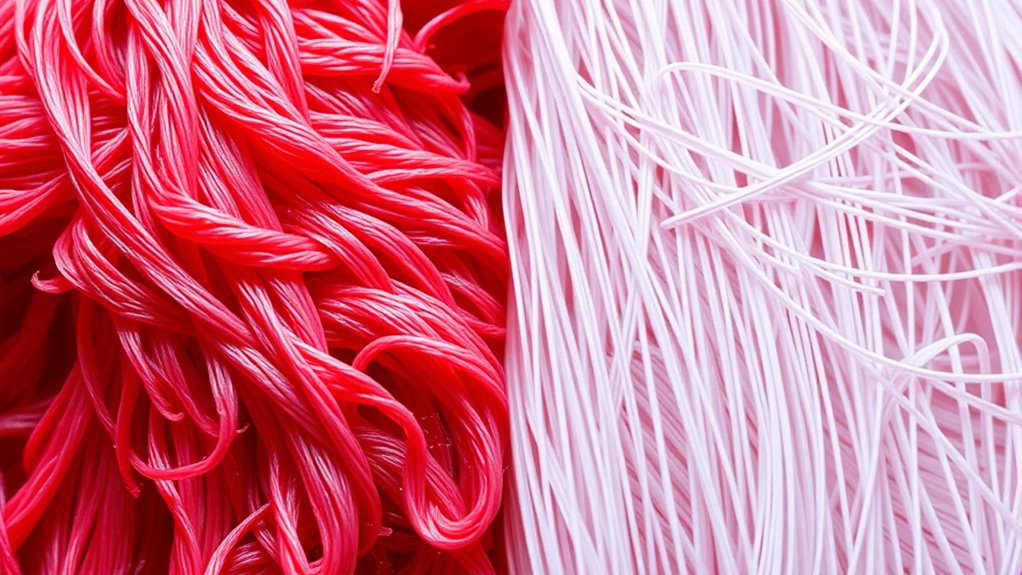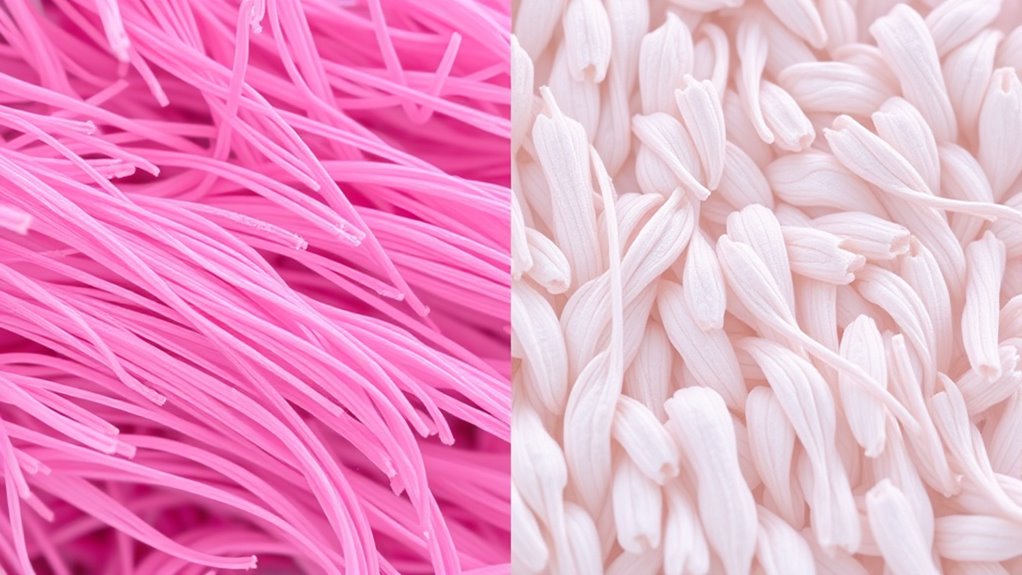Understanding muscle fiber types helps you see how your muscles perform during different activities. Slow-twitch fibers are efficient for endurance, using oxygen to sustain long, steady efforts like running or cycling. Fast-twitch fibers generate quick, powerful movements like sprinting or jumping but fatigue faster. Your muscles have both types, and how they respond depends on your training. If you want to learn more about optimizing your workouts and performance, there’s plenty more to explore.
Key Takeaways
- Slow-twitch fibers (Type I) excel in endurance and aerobic activities, while fast-twitch fibers (Type II) are suited for explosive, anaerobic movements.
- Slow-twitch fibers are fatigue-resistant due to high mitochondrial density, unlike fast-twitch fibers which fatigue quickly but generate more force.
- Training can induce adaptations in muscle fibers, enhancing endurance in slow-twitch or power in fast-twitch fibers.
- Muscle fiber composition influences athletic performance, with endurance athletes favoring slow-twitch and sprinters relying on fast-twitch fibers.
- The recruitment pattern depends on activity intensity: low for slow-twitch, high for fast-twitch fibers.

Have you ever wondered why some athletes excel in sprinting while others dominate long-distance running? The answer lies in the different types of muscle fibers your body uses during various physical activities. Your muscles are made up of fibers that are specialized for specific functions, primarily categorized as slow-twitch and fast-twitch fibers. Understanding these fiber types can shed light on how your body responds to training and why certain sports suit some athletes better than others.
Slow-twitch fibers, also known as Type I fibers, are highly efficient at using oxygen to generate energy over extended periods. When you engage in endurance activities like marathon running or cycling, your body primarily recruits these fibers. They are resistant to fatigue because they rely on aerobic metabolism, which provides a steady supply of energy for prolonged efforts. As you train with endurance exercises, your muscles undergo training adaptations that enhance the efficiency and capacity of these slow-twitch fibers. You might notice increased mitochondrial density, improved capillary networks, and greater stamina as a result of consistent aerobic training. These adaptations allow your slow-twitch fibers to sustain activity longer, making them perfect for endurance sports.
On the other hand, fast-twitch fibers, or Type II fibers, are built for quick, powerful movements. They generate more force but fatigue faster because they rely more on anaerobic metabolism, which doesn’t require oxygen and produces energy rapidly. When you perform explosive movements like sprinting, jumping, or heavy lifting, your body primarily recruits these fast-twitch fibers. Training adaptations in these fibers include increased size (hypertrophy), improved phosphocreatine stores, and enhanced ability to produce rapid force. These changes help you maximize power and speed, making fast-twitch fibers essential for athletes involved in sprinting or weightlifting.
Your body’s fiber recruitment pattern depends heavily on the intensity and duration of activity. During low-intensity, long-duration efforts, slow-twitch fibers are mainly engaged. As activity intensity increases, your body shifts to recruit more fast-twitch fibers to generate the necessary force. This selective recruitment is why training programs often aim to target specific fiber types to improve performance in particular sports.
Furthermore, research indicates that understanding the muscle fiber composition of an individual can help tailor training programs for optimal results. In essence, your muscle fiber composition and the way your body recruits these fibers during activity shape your athletic capabilities. Training adaptations fine-tune the function of both fiber types, enhancing endurance or explosive power depending on your focus. Recognizing the differences between slow-twitch and fast-twitch fibers helps you understand how your body responds to training and why tailored exercise programs yield the best results for your athletic goals.
Frequently Asked Questions
Can Muscle Fiber Types Change Over a Person’s Lifetime?
Yes, muscle fiber types can change over your lifetime thanks to muscle adaptability. While your genetic predisposition influences your natural balance of slow-twitch and fast-twitch fibers, consistent training can shift this balance. For example, endurance workouts may enhance slow-twitch fibers, while strength training boosts fast-twitch fibers. So, with targeted effort, you can influence your muscle composition to suit your fitness goals.
How Do Diet and Supplements Influence Muscle Fiber Composition?
Diet and supplements can steer your muscle fiber composition like a captain guiding a ship. Nutritional impact, especially protein intake, influences muscle growth and recovery, potentially favoring fast-twitch fibers for strength. Supplements like creatine can boost power and muscle size, affecting fiber types over time. While you can’t drastically change your fiber makeup, smart nutrition and supplements can enhance your performance by supporting your natural muscle potential.
Are Certain Sports Better Suited for Specific Muscle Fiber Types?
Yes, certain sports suit specific muscle fiber types. If you excel in sports requiring muscle endurance, like marathon running, your slow-twitch fibers are advantageous because they sustain activity longer. Conversely, sports demanding explosive power, such as sprinting or weightlifting, benefit from fast-twitch fibers that generate quick, powerful movements. By training appropriately, you can optimize your muscle fiber composition to improve performance in your chosen sport.
How Does Aging Affect the Distribution of Muscle Fiber Types?
As you age, you’ll experience muscle atrophy, which leads to a decline in muscle mass and strength. This process can cause fiber transformation, often reducing fast-twitch fibers and preserving slow-twitch fibers. Consequently, your muscles may become more endurance-oriented but less powerful. Regular strength training can combat these effects by promoting muscle fiber maintenance and potentially reversing some age-related fiber shifts.
Can Training Selectively Transform Slow-Twitch Into Fast-Twitch Fibers?
Ever wonder if you can change your muscle fibers? While training specificity influences fiber transformation, you can’t truly convert slow-twitch fibers into fast-twitch ones. Instead, you enhance their strength and size through targeted workouts. Your muscles adapt based on the type of training you do, but the fundamental fiber types stay relatively the same. Focus on training that aligns with your goals to maximize performance.
Conclusion
So, now that you know about slow-twitch and fast-twitch fibers, you’re basically a muscle expert, right? Just remember, whether you’re leisurely jogging or sprinting like a cheetah, your muscles are doing their best impression of a superhero. Next time you hit the gym, think about which fiber type you’re calling into action—because who knew your muscles had such a dramatic personality? Now go forth and flex with the wisdom of a muscle connoisseur!









